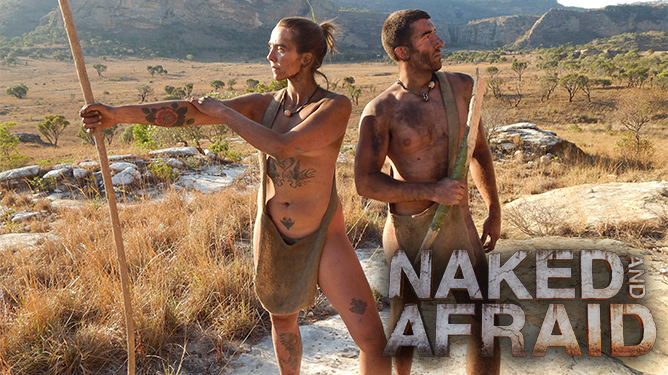There is a new television series called, Naked and Afraid. The basic premise is that they drop two people into a hostile part of the world and they have to survive for 21 days.  Each survivalist gets to take a single item with them. This is usually a machete or a technological fire starter. However, they are taking the most important survival tools inside their skulls. The keys to survival, from a jungle in Columbia to a Walmart parking lot, are the abilities to be scared and feel pain.
Each survivalist gets to take a single item with them. This is usually a machete or a technological fire starter. However, they are taking the most important survival tools inside their skulls. The keys to survival, from a jungle in Columbia to a Walmart parking lot, are the abilities to be scared and feel pain.
If  you doubt this, consider the following quote – “About one in a million people are thought to be born without a sense of pain, which results in severe self-inflicted injuries from an early age and can lead to premature death.” Duh. Imagine walking barefoot on sharp rocks and not being able to sense that you are cutting yourself to ribbons. Imagine walking right up to a jaguar and not being afraid. The absence of correct reactions to fear and pain often lead to premature death. You can take that to the bank or the graveyard – your choice.
you doubt this, consider the following quote – “About one in a million people are thought to be born without a sense of pain, which results in severe self-inflicted injuries from an early age and can lead to premature death.” Duh. Imagine walking barefoot on sharp rocks and not being able to sense that you are cutting yourself to ribbons. Imagine walking right up to a jaguar and not being afraid. The absence of correct reactions to fear and pain often lead to premature death. You can take that to the bank or the graveyard – your choice.
Despite the critical importance of these biological functions, modern psychologists, animal trainers, educators and a wide stripe of the general public believe the opposite. They think and preach a mantra of ice-cream, aroma therapy and supportive confirmations that everyone is special. Huh? To divert for a second, let’s examine where our perception of pain and fear come from and why we retain them. If you want to get all “science-like” the topic is called phylogeny – the physical qualities that are common to a specific phylum or species. (Note: Modern behavioral scientists have a problem with saying “instinct” or recognizing that our brains are part of our bodies and function as any other internal organ – to provide a specific service to the whole.)
The Wonderful Gifts of Pain, Fear and Terror:
The reason we, and our dogs, have the ability to sense pain and experience fear and terror is because our distant ancestors needed them to be able to reproduce and survive. Pain, fear and terror are neither good nor bad – they are simply mechanisms that have allowed various species to reproduce and perpetuate their existence. While Darwin never said the phrase, “Survival of the Fittest”, the closest he would have come would have been to use the word “fit” as in ‘hand to glove’. Those species whose physical nature allowed them to breed and reproduce preserved their genes. Those who didn’t are no longer with us. The genes we have today were created and edited by basic survival. A magnificent body with no capacity to behave is a dead-dog walking. Likewise, behavior without a functional body is like an exotic cat, paralyzed by a dart filled with nicotine sulfate. The brain is still active but the ability to move is gone. The concept that behavior is disconnected from the body is stupid. They are indivisible. The physical ability to feel pain and the “mental” ability to experience fear and terror are as necessary today as they were 50,000 years ago. A rational person would be grateful we have them – or try to acquire at least six friends to carry their casket.
Pain:
The evolutionary justification for our ability to sense pain is that without it our ancestors would not have survived. I should qualify this by saying that the brain has an override mechanism that allows us to ignore pain for short periods of time. Meaning if we didn’t need the ability to react to pain we wouldn’t have it. Ironically, people who cannot feel pain live in fear – fear of damaging themselves without knowing it. In general, pain teaches us what to avoid. The process whereby a painful event causes us to suppress a behavior is called contingent positive punishment. Go touch a cactus needle if you do not immediately know what I am talking about. Touch it once and you’re done. Note: Many behavior analysts oppose punishment because it doesn’t teach the organism what to do.
“ But just punishing the animal for doing something else does not teach it to sit. At most, punishment only teaches it what not to do.” Murray Sidman, Coercion and Its Fallout
Sorry, Murray, punishment is supposed to stop behavior. It is not supposed to teach the animal what to do. The brakes on the car don’t make it go faster. Your seat belt doesn’t help you to move around in your seat. A screw, correctly tightened, does not allow two pieces of wood or metal to move, either.
So, pain tells you what to avoid. It can also tell us how to modify a behavior to avoid a similar result in the future. If you have a blister on the ball of your foot, you will modify your gait to avoid putting full pressure on it. Without pain you would injure your foot further with each step. If you are sophisticated you might put a bandage on your blister to allow you to walk normally. In essence, medical treatment revolves around pain. A common request of a doctor is, “Tell me where it hurts.” This leads to proper diagnosis and treatment. Gee, who’d want that?
The reality is that the perspective of modern behavioral science and modern, scientific trainers is irrational. It suggests that natural physiological functions are either good or bad, regardless of context. Imagine opposing blood pressure as a principle of medicine. That would be equally irrational or, from my perspective, stupid.
For me, I like pain and fear. They keep me alive. They are not perfect, nor are they supposed to be. Sometimes I feel a ghost pain in my shoulder where I had surgery when I was 21. I have a rational fear of people driving large vehicles while texting. I have an almost obsessive devotion to knowing if a firearm is loaded or not. I can’t think of any irrational fears at the moment. I think that is the goal. Use your fear and pain to find out reality, then adapt to it. I do not fear vicious dogs, though my baby book recalls that at age three, my biggest fear was dogs. Vicious dogs may initially fear me. That’s a good thing. I use it to make them better dogs. Then they, like me, no longer fear. If pain is a part of their learning I am not bothered by that any more than when a slap-shot phlebotomist can’t find a vein in my arm. The issue is whether pain and fear are acceptable, unavoidable parts of the process of creating a better life. The flip side is withholding training that might cause pain or fear while leaving the animal in jeopardy. That last part condemns an animal to a life of ever-ratcheting confinement or no life at all. I choose life.

I wonder if this can apply to human behavioral psychologists; do they avoid pain in any way possible and only focus on the positive?
In my special education classes, they teach us about Applied Behavioral Analysis (ABA) and Cognitive Behavioral Intervention (CBI). Within this teaching I don’t hear much about punishment because I’m guessing that science and human population has validated it as outdated? I always here about redirection, redirection, redirection but from dog psychology this does not always a work because the wanted can be worth more than the redirection. With all this positive parenting and “don’t whip the child” I can see it, yet when I read your articles you give me a good perspective to hold onto and thinking that is different from the average learner–thank you.
Anyways, how do you recommend a future educator like me develop a proper philosophy of holding students accountable to their actions through some kind of negative reinforcement and approving the positive through encouragement or praise?